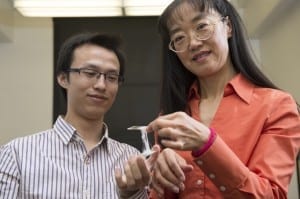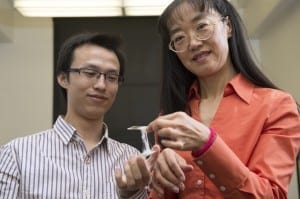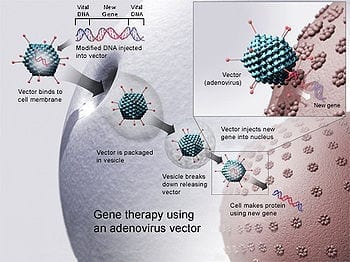
A group of Washington State University researchers has developed a chewing gum-like battery material that could dramatically improve the safety of lithium ion batteries.
Led by Katie Zhong, Westinghouse Distinguished Professor in the School of Mechanical and Materials Engineering, the researchers recently reported on their work in the journal, Advanced Energy Materials. They have also filed a patent.
High performance lithium batteries are popular in everything from computers to airplanes because they are able to store a large amount of energy compared to other batteries. Their biggest potential risk, however, comes from the electrolyte in the battery, which is made of either a liquid or gel in all commercially available rechargeable lithium batteries. Electrolytes are the part of the battery that allow for the movement of ions between the anode and the cathode to create electricity. The liquid acid solutions can leak and even create a fire or chemical burn hazard.
While commercial battery makers have ways to address these safety concerns, such as adding temperature sensors or flame retardant additives, they “can’t solve the safety problem fundamentally,’’ says Zhong.
Zhong’s research group has developed a gum-like lithium battery electrolyte, which works as well as liquid electrolytes at conducting electricity but which doesn’t create a fire hazard.
Researchers have been toying around with solid electrolytes to address safety concerns, but they don’t conduct electricity well and it’s difficult to connect them physically to the anode and cathode. Zhong was looking for a material that would work as well as liquid and could stay attached to the anode and cathode – “like when you get chewing gum on your shoe,’’ she told her students.
Advised by Zhong, graduate student Yu “Will” Wang designed his electrolyte model specifically with gum in mind. It is twice as sticky as real gum and adheres very well to the other battery components.
The material, which is a hybrid of liquid and solid, contains liquid electrolyte material that is hanging on solid particles of wax or a similar material. Current can easily travel through the liquid parts of the electrolyte, but the solid particles act as a protective mechanism. If the material gets too hot, the solid melts and easily stops the electric conduction, preventing any fire hazard. The electrolyte material is also flexible and lightweight, which could be useful in future flexible electronics. You can stretch, smash, and twist it, and it continues to conduct electricity nearly as well as liquid electrolytes. Furthermore, the gummy electrolyte should be easy to assemble into current battery designs, says Zhong.
The Latest on: Lithium ion batteries
[google_news title=”” keyword=”Lithium ion batteries” num_posts=”10″ blurb_length=”0″ show_thumb=”left”]
via Google News
The Latest on: Lithium ion batteries
- Sodium batteries from Michigan to challenge lithium’s gripon May 4, 2024 at 5:00 pm
Modern life runs on lithium-ion batteries, powering smartphones, laptops and electric cars alike. But as dominant as they’ve become, there are other ways to build a battery. Natron Energy Inc. will ...
- China’s water battery has almost double energy capacity than lithium cellson May 4, 2024 at 3:41 am
A water-based battery design from China boasts increased safety and double the power, promising advancements in electric vehicle technology.
- First Aid Friday: Lithium-ion Batterieson May 3, 2024 at 9:34 am
Lithium-ion batteries are lightweight, safe, and you can find them powering everything from cars to cell phones — but they’re also prone to counterfeiting and can be a real fire hazard ...
- Charging future EVs could take seconds with new sodium-ion battery techon May 3, 2024 at 4:01 am
A new type of hybrid sodium-ion battery that offers both high capacity and rapid-charging capabilities could power mobile devices, electric vehicles and space tech.
- Cost-effective, high-capacity and cyclable lithium-ion battery cathodeson May 2, 2024 at 10:30 am
Charge-recharge cycling of lithium-super-rich iron oxide, a cost-effective and high-capacity cathode for new-generation lithium-ion batteries, can be greatly improved by doping with readily available ...
- Best lithium stocks May 2024on May 1, 2024 at 5:00 pm
Its specialty transportation batteries supply the premium segments of the truck and passenger vehicle markets. The company is investing in higher-value premium products, including lithium-ion ...
- Toyota, Argonne National Lab study lithium-ion battery recyclingon April 30, 2024 at 5:00 pm
RELATED: DOE opens lithium-ion battery recycling center Toyota will provide Argonne with end-of-life and new Toyota batteries. Using these batteries, Argonne will adapt and test its patent pending ...
- Sodium-ion batteries from Michigan plant to challenge lithium’s gripon April 29, 2024 at 11:22 am
Natron Energy Inc. bills the facility near the Lake Michigan shore as the first full-scale U.S. plant for making sodium-ion batteries.
- Crawford shares advice on managing lithium-ion battery riskson April 29, 2024 at 9:34 am
To address the growing risk, the Federal Government issued a national product safety notice, following an Australian Competition and Consumer Commission (ACCC) recommendation, alerting consumers to ...
- Lithium-ion vs lithium-polymer batteries: What's the difference?on April 27, 2024 at 5:00 pm
Lithium-ion (Li-ion) battery technology has historically been the power cell of choice for smartphones and a wide range of other portable gadgets too. However, modern smartphones now commonly ...
via Bing News











